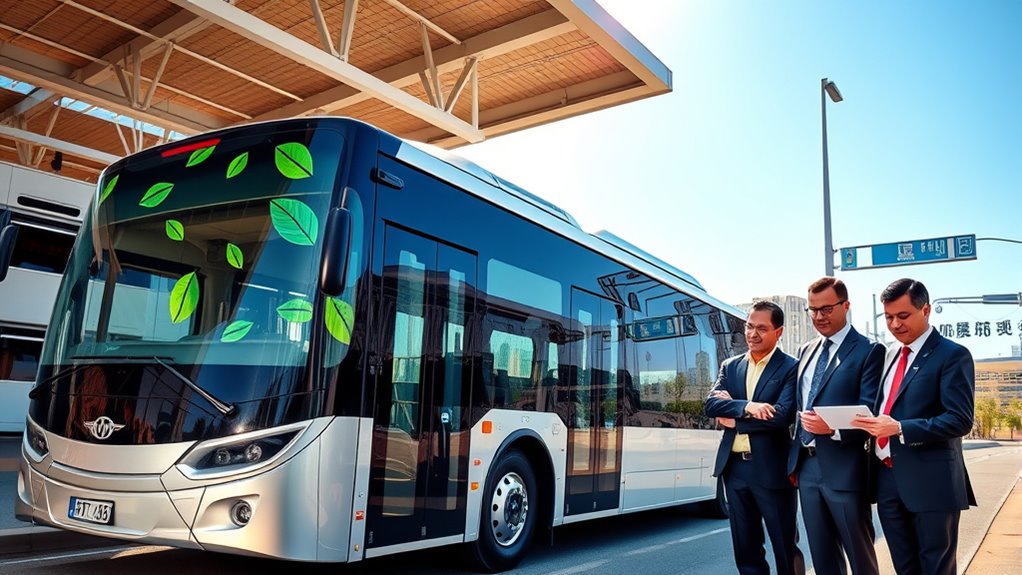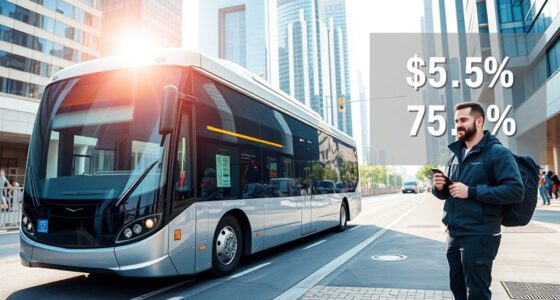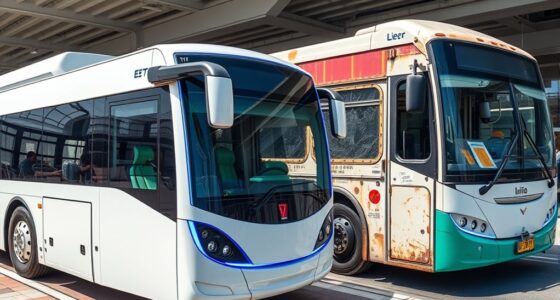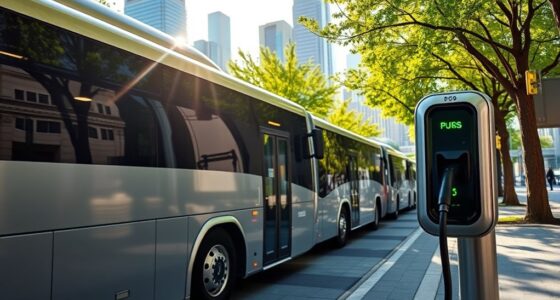You can access federal, state, and local incentives that make buying electric buses more affordable. Federal programs like the EPA’s Clean School Bus Program and the Inflation Reduction Act offer grants, tax credits, and rebates that reduce upfront costs. Many states provide additional rebates and low-interest financing, while regional initiatives push for more zero-emission transit options. Staying informed about these incentives can help you maximize savings and make the switch easier—learn more to open these opportunities.
Key Takeaways
- The EPA’s Clean School Bus Program offers up to $5 billion (2022-2026) for replacing diesel buses with electric or clean alternatives.
- Under the Inflation Reduction Act, electric school buses qualify for up to $40,000 federal tax credits via the Qualified Commercial Clean Vehicle Credit.
- Charging stations are eligible for a 30% federal tax credit, up to $100,000 per station under Section 30C.
- State and regional programs provide grants, rebates, and discounted rates to support electric bus adoption, especially in underserved communities.
- Transit agencies and nonprofits can access dedicated grants for vehicle purchase and infrastructure, reducing overall costs.

Are you considering switching to electric buses? If so, you’ll find that the federal government offers a range of incentives designed to make your transition more affordable. One of the most important programs is the EPA Clean School Bus Program, which allocates $5 billion over five years (2022-2026) specifically for replacing traditional diesel school buses with zero-emission or clean alternatives. This program aims to reduce emissions and improve air quality in communities, especially in underserved areas.
Federal incentives, like the EPA Clean School Bus Program, support replacing diesel buses with zero-emission alternatives to improve air quality.
In addition, the DERA (Diesel Emissions Reduction Act) program provides funding to replace diesel vehicles—including school buses—with electric vehicles, along with grants for charging infrastructure installation. These grants prioritize underserved communities and support projects that demonstrate emissions reductions. Understanding program eligibility can help streamline the application process and improve your chances of securing funding.
State and regional programs further complement federal efforts, offering local incentives such as rebates, grants, and discounted charging rates through utility partnerships. Many states have their own grants to support EV adoption, and some regions have mandates to accelerate the shift toward zero-emission buses to meet climate and air quality goals. These programs often target pilot projects or early adopters, helping demonstrate the technology’s viability and encouraging wider adoption.
If you’re a transit agency, local government, or nonprofit, you may qualify for dedicated funding or grants to assist with both vehicle purchase and infrastructure development. Additionally, understanding program eligibility can help streamline the application process and improve your chances of securing funding. Staying informed about policy changes and regional initiatives can also present additional opportunities to maximize your funding potential.
Tax credits also play a vital role in reducing the upfront costs of electric buses. Under the Inflation Reduction Act, you could receive a credit of up to $40,000 per electric school bus through the Qualified Commercial Clean Vehicle Credit (Section 45W). Charging stations are also eligible for a 30% tax credit, up to $100,000 per station, via Section 30C.
If you’re a tax-exempt entity like a school district, you can take advantage of the Elective Pay Provision, which allows you to claim these credits as direct cash payments, making the financial benefits more accessible. These incentives are available until December 2032, giving you ample time to plan your transition.
Using specialized vacuums for certain flooring types, such as luxury vinyl plank (LVP) floors, can help prevent damage and maintain the surface’s appearance. Applying these federal, state, and local incentives is straightforward but requires some planning. You’ll need to submit the appropriate IRS forms for direct payments or detailed proposals for grants, often including proof of retiring diesel buses. Some programs, like the EPA’s rebate system, allocate funds through lotteries, so timely applications increase your chances.
Infrastructure grants are typically paired with vehicle purchases, ensuring you can develop a complete electric bus system. By leveraging these federal, state, and local incentives, you can considerably reduce the costs associated with buying and operating electric buses, making the switch not only environmentally beneficial but financially smart as well.
Frequently Asked Questions
Are There Specific Incentives for Small or Rural Transit Agencies?
You’re wondering if small or rural transit agencies get special incentives. Yes, they do. Programs like Rural Transit Incentives offer grants under $1 million, making it easier for these agencies to fund electric buses and infrastructure.
These targeted grants help overcome funding gaps, enabling rural agencies to adopt cleaner transportation options. Keep in mind, eligibility often requires specific criteria, but these incentives are designed to support smaller and rural transit operators.
How Do Incentives Differ Between New and Used Electric Buses?
You’re wondering how incentives differ between new and used electric buses. Currently, federal programs mainly support new buses, offering grants that cover up to 100% of costs, especially in disadvantaged areas.
In contrast, used electric buses lack dedicated federal funding, though some local initiatives provide tax credits or incentives for refurbishments.
What Are the Eligibility Criteria for Government Incentives?
You need to meet specific eligibility criteria to access government incentives. Make sure you’re an eligible applicant, like a school district, non-profit, or local government, and register with the proper programs.
Your project should involve zero-emission buses, and you might need to develop a transition plan.
Also, adhere to wage standards, and consider income requirements if applicable.
These steps help qualify you for rebates, grants, and other financial assistance aimed at supporting clean transportation.
Are There Incentives for Private Companies Using Electric Buses?
You can get incentives if your private company uses electric buses, especially if you meet specific criteria. These include having limited revenue (often under $15 million), operating a small fleet, and using vehicles over 8,500 pounds GVWR.
Incentives like vouchers, tax credits, and rebates can help offset costs, making electric buses more affordable. Check your state’s programs and industry requirements to see if you qualify for these financial benefits.
How Long Does It Take to Receive Incentive Funding?
You might worry about how long it takes to get incentive funding, but the process can be swift if you act promptly. Once you submit your application, approval often depends on first-come, first-served basis, and it can take just a few weeks to a couple of months for processing.
After approval, you’ll need to redeem your voucher within about 15 months, so staying on top of deadlines helps ensure a smooth funding experience.
Conclusion
By taking advantage of government incentives for electric buses, you’re not just making a smart choice—you’re revolutionizing urban transportation and saving the planet in one fell swoop. Imagine leading the charge in a global movement so powerful, it could be the difference between a sustainable future and an ecological catastrophe. Don’t settle for ordinary; seize these incentives and become a trailblazer in green mobility that will be remembered for generations to come.









